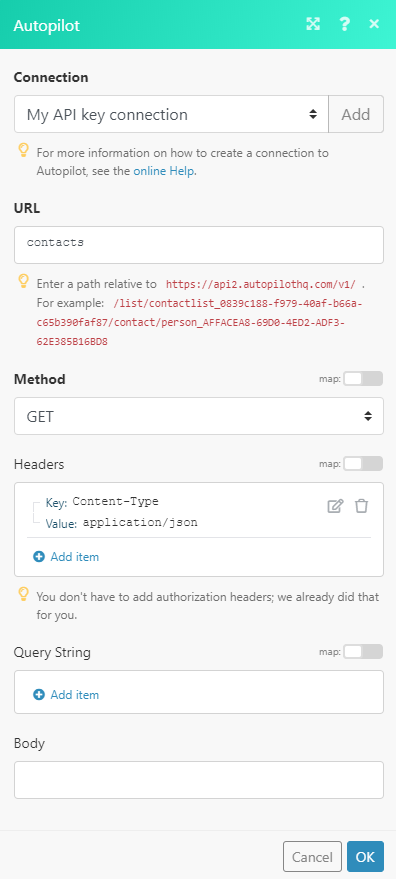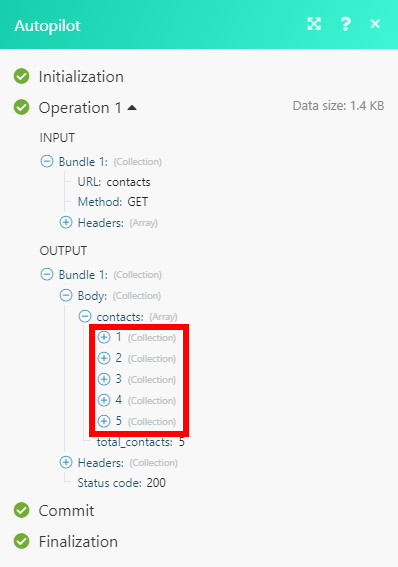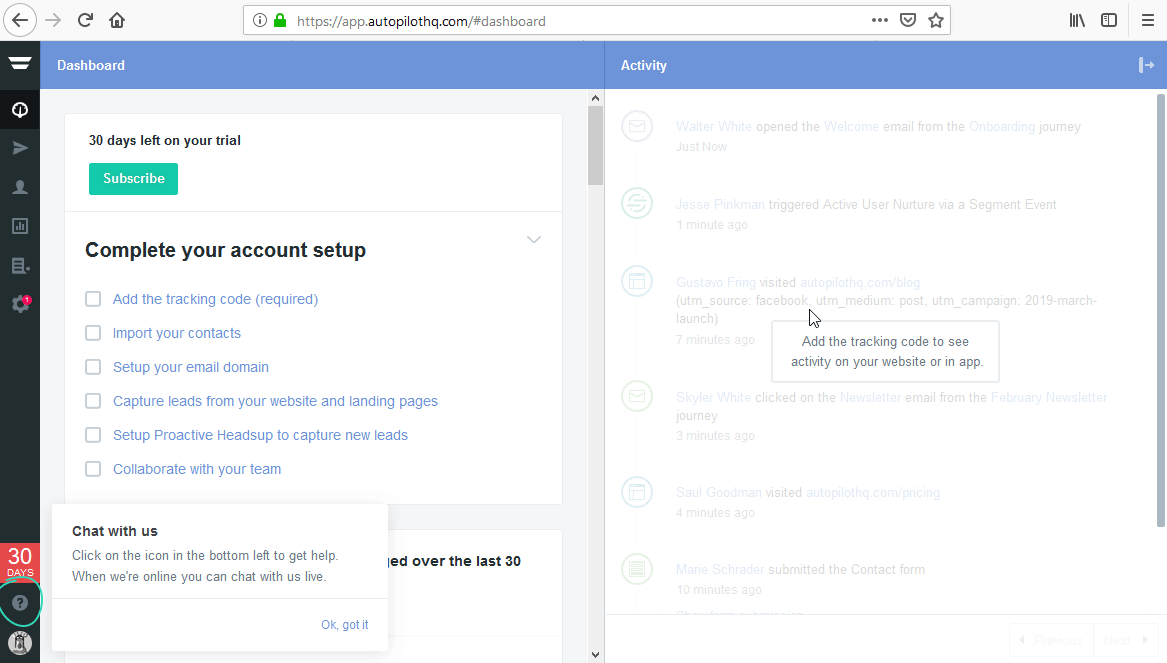| Active with remarks |
|---|
| This application needs additional settings. Please follow the documentation below to create your own connectionUnique, active service acces point to a network. There are different types of connections (API key, Oauth…). More. |
The Autopilot modulesThe module is an application or tool within the Boost.space system. The entire system is built on this concept of modularity. (module - Contacts) More allow you to monitor, create, retrieve, delete, update, search contacts and lists in your Autopilot account.
Prerequisites
-
An Autopilot account
In order to use Autopilot with Boost.spaceCentralization and synchronization platform, where you can organize and manage your data. More IntegratorPart of the Boost.space system, where you can create your connections and automate your processes. More, it is necessary to have an Autopilot account. If you do not have one, you can create an Autopilot account at www.autopilothq.com/signup.
![[Note]](https://docs.boost.space/wp-content/themes/bsdocs/docs-parser/HTML/css/image/note.png) |
Note |
|---|---|
|
The moduleThe module is an application or tool within the Boost.space system. The entire system is built on this concept of modularity. (module - Contacts) More dialog fields that are displayed in bold (in the Boost.space Integrator scenarioA specific connection between applications in which data can be transferred. Two types of scenarios: active/inactive. More, not in this documentation article) are mandatory! |
To connect your Autopilot account to Boost.space Integrator you need to get the API Key from the Autopilot account and insert it into the Boost.space Integrator Autopilot module.
-
Log in to your Autopilot account.
-
Open the Settings page.
-
Open the Autopilot API settings.
-
Click the Generate button and copy the generated Autopilot API Key.
-
Go to Boost.space Integrator and open the Create a connection dialog of the desired Autopilot module. Enter the copied API Key to the respective field.
-
Click Continue to establish the connection.
TriggersEvery scenario has a trigger, an event that starts your scenario. A scenario must have a trigger. There can only be one trigger for each scenario. When you create a new scenario, the first module you choose is your trigger for that scenario. Create a trigger by clicking on the empty module of a newly created scenario or moving the... when a contact is created, updated, unsubscribed, added to a list, removed from a list, entered to a segment, or has left a segment.
|
WebhookA webhook is a way for an app to send real-time information to a specific URL in response to certain events or triggers. name |
Enter a name for the webhook. E.g. contact added |
|
|
Connection |
||
|
Event |
Contact added Triggers when a contact is added to your Autopilot account: manually, using a spreadsheet import, a Salesforce sync, an API Call, a Zapier event, or a Segment.com event. Contact updated Triggers when a contact is modified: manually, by a spreadsheet import which includes new information, by a Salesforce sync which includes new information, by an API Call which adds details to contacts, when the contact unsubscribes, a Zapier event, a Segment.com event, or other Autopilot events which update contact information. Contact unsubscribed Triggers when a contact unsubscribes from emails: manually by unchecking the box in the contact profile, a Salesforce sync causes the unsubscribe field to be updated, a field update on a journey causes the contact to be unsubscribed, or the contact clicks an unsubscribe link in an email you send. Contact added to list Triggers when a contact is added to a list: manually using the contacts section of the Autopilot UI, in a journey which has a step that adds contacts to a list and the contact reaches it, by an API call, or by contact import. Contact removed from list Triggers when a contact is removed from a list: manually using the contacts section of the Autopilot UI, in a journey which a step that removes contacts from a list and the contact reaches it, or by an API call. Contact entered segment Triggers when a contact enters the segment by meeting the segment criteria. Contact left segment Triggers when a contact leaves the segment by no longer meeting the segment criteria |
Updates an existing contact.
![[Note]](https://docs.boost.space/wp-content/themes/bsdocs/docs-parser/HTML/css/image/note.png) |
Note |
|---|---|
|
To clear the value from the field please use the keyword |

|
Connection |
||||
|
Email address |
Enter the email address of the contact you want to update. |
|||
|
New email |
Enter a new email address for the contact. |
|||
|
First name |
Enter the first name of the contact. |
|||
|
Last name |
Enter the last name of the contact. |
|||
|
|
Enter the contact’s Twitter account address. |
|||
|
Salutation |
Enter the contact salutation. |
|||
|
Number of employees |
Number of employees of the contact’s company. |
|||
|
Company |
Enter the name of the contact’s company. |
|||
|
Title |
Enter the job title. |
|||
|
Industry |
Enter the company’s industry |
|||
|
Phone |
Enter the contact’s phone number. |
|||
|
Mobile phone |
Enter the contact’s mobile phone number. |
|||
|
Fax |
Enter the contact’s fax number. |
|||
|
Website |
Enter the contact’s website. |
|||
|
Mailing address |
Enter the mailing street, city, postal code, and country for the contact. |
|||
|
OwnerCan manage members, managers and owners of a specific space. Can view and manage items. Can edit settings of a given space. More name |
Enter the owner of the lead. |
|||
|
Lead source |
Enter the lead source. |
|||
|
StatusCreate statuses for each module separately to create an ideal environment for efficient and consistent work. More |
Enter the status of the contact. |
|||
|
|
Enter the contact’s LinkedIn account address. |
|||
|
Unsubscribed |
If the Yes option is selected, the email permission will be set to unsubscribed. |
|||
|
Session ID |
Enter the session ID. If you’re using Autopilot’s Tracking Code, you can associate a visitor session to a contact with the Session ID contact field. |
|||
|
List |
Enter the ID of the list you want to insert the contact to. E.g.
|
|||
|
Use custom fieldsA feature in Boost.space that allows you to define and manage data within each module according to your specific needs. More? |
Select whether you want to use custom fields. If you select the Yes option, then a custom fieldA feature in Boost.space that allows you to define and manage data within each module according to your specific needs. More appears and you can fill in the desired value in the field.
|
Retrieves details of the selected contact.
|
Connection |
|
|
Contact ID or email |
Select whether you want to choose the contact by email or contact ID. |
|
Contact ID/Email |
Select the ID or email you want to retrieve information about. |
Deletes a contact.
|
Connection |
|
|
Contact ID or email |
Select whether you want to choose the contact by email or contact ID. |
|
Contact ID/Email |
Select the ID or email you want to delete. |
Unsubscribes the selected contact from receiving emails from your Autopilot Journeys.
|
Connection |
|
|
Contact ID or email |
Select whether you want to choose the contact by email orcontact ID. |
|
Contact ID/Email |
Select the ID or email you want to unsubscribe from receiving emails. |
Adds a new list. Lists are used in Autopilot to group contacts together. A contact can belong to as many lists as you like.
![[Note]](https://docs.boost.space/wp-content/themes/bsdocs/docs-parser/HTML/css/image/note.png) |
Note |
|---|---|
|
If you specify a list name which already exists, a sequential number will be added to the end of the list name. |
|
Connection |
|
|
List name |
Enter the name for a new list. |
Checks if a contact belongs to a specified list.
![[Note]](https://docs.boost.space/wp-content/themes/bsdocs/docs-parser/HTML/css/image/note.png) |
Note |
|---|---|
|
If the operationAn operation is a task performed by module. More fails with the error |
|
Connection |
|
|
List ID |
Select or map the list you want to check for the contact presence. |
|
Contact ID or email |
Select whether you want to choose the contact by email orby contact ID. |
|
Contact ID/Email |
Enter (map) the ID or email you want to check. |
Adds selected contact to a list.
|
Connection |
|||||||
|
List ID |
Select or map the list you want to add a contact to. |
||||||
|
Contact ID or email |
Select whether you want to choose the contact by email orcontact ID. |
||||||
|
Contact ID/Email |
Select the ID or email you want to add to the list.
|
Removes a contact from the list.
|
Connection |
|
|
List ID |
Select or map the list you want to remove the contact from. |
|
Contact ID or email |
Select whether you want to choose the contact by email orcontact ID. |
|
Contact ID/Email |
Select the ID or email you want to remove from the list. |
Retrieves the data of an email campaign.
|
Connection |
|
|
Email ID |
Enter the ID received in the Autopilot Activity Stream. |
This method was added to help Autopilot customers comply with GDPR deletion requests. Calling this method with the contact ID or email address of the customer will result in their entire activity feed being deleted.
|
Connection |
|
|
Contact ID or email |
Select whether you want to choose the contact by email or contact ID. |
|
Contact ID/Email |
Select the ID or email of whose activity feed you want to delete. |
|
Which activities? |
Select whether you want to delete all activity of the contact, or only the visited pages. |
Adds a contact to a journey.

|
Connection |
|
|
TriggerEvery scenario has a trigger, an event that starts your scenario. A scenario must have a trigger. There can only be one trigger for each scenario. When you create a new scenario, the first module you choose is your trigger for that scenario. Create a trigger by clicking on the empty module of a newly created scenario or moving the... ID |
Select or map the trigger you want to add a contact to. |
|
Contact ID or email |
Select whether you want to choose the contact by email orcontact ID. |
|
Contact ID/Email |
Select the ID or email of the contact you want to add to the journey. |
Creates a new contact.
|
Connection |
||||
|
Email address |
Enter an email address for the contact.
|
|||
|
First name |
Enter the first name of the contact. |
|||
|
Last name |
Enter the last name of the contact. |
|||
|
|
Enter the contact’s Twitter account address. |
|||
|
Salutation |
Enter the contact salutation. |
|||
|
Number of employees |
Number of employees of the contact’s company. |
|||
|
Company |
Enter the name of the contact’s company. |
|||
|
Title |
Enter the job title. |
|||
|
Industry |
Enter the company’s industry |
|||
|
Phone |
Enter the contact’s phone number. |
|||
|
Mobile phone |
Enter the contact’s mobile phone number. |
|||
|
Fax |
Enter the contact’s fax number. |
|||
|
Website |
Enter the contact’s website. |
|||
|
Mailing address |
Enter the mailing street, city, postal code, and country for the contact. |
|||
|
Owner name |
Enter the owner of the lead. |
|||
|
Lead source |
Enter the lead source. |
|||
|
Status |
Enter the status of the contact. |
|||
|
|
Enter the contact’s LinkedIn account address. |
|||
|
Unsubscribed |
If the Yes option is selected, the email permission will be set to unsubscribed. |
|||
|
Session ID |
Enter the session ID. If you’re using Autopilot’s Tracking Code, you can associate a visitor session to a contact with the Session ID contact field. |
|||
|
List |
Enter the ID of the list you want to insert the contact to. E.g.
|
|||
|
Use custom fields? |
Select whether you want to use custom fields. If you select the Yes option, then a custom field appears and you can fill the desired value to the field.
|
Returns all contacts (with details).
|
Connection |
|
|
Limit |
Set the maximum number of contacts Boost.space Integrator will return during one cycleA cycle is the operation and commit/rollback phases of scenario execution. A scenario may have one or more cycles (one is the default).. |
Returns all journeys, where the API Trigger is used.
|
Connection |
|
|
Limit |
Set the maximum number of journeys Boost.space Integrator will return during one cycle. |
Retrieves all lists.
|
Connection |
|
|
Limit |
Set the maximum number of lists Boost.space Integrator will return during one cycle. |
Retrieves contacts that belong to a specified list.
|
Connection |
|
|
Limit |
Set the maximum number of contacts Boost.space Integrator will return during one cycle. |
|
List ID |
Select the list you want to retrieve contacts from. |
Retrieves contacts that belong to a specified segment.
|
Connection |
|
|
Limit |
Set the maximum number of contacts Boost.space Integrator will return during one cycle. |
|
Segment ID |
Select the segment you want to retrieve contacts from. |
Retrieves all segments.
|
Connection |
|
|
Limit |
Set the maximum number of segments Boost.space Integrator will return during one cycle. |
Allows you to perform a custom API call.
|
Connection |
||||
|
URL |
Enter a path relative to
|
|||
|
Method |
Select the HTTP method you want to use: GET to retrieve information for an entry. POST to create a new entry. PUT to update/replace an existing entry. PATCH to make a partial entry update. DELETE to delete an entry. |
|||
|
Headers |
Enter the desired request headers. You don’t have to add authorization headers; we already did that for you. |
|||
|
Query string |
Enter the request query string. |
|||
|
Body |
Enter the body content for your API call. |
The following API call returns all contacts:

Matches of the search can be found in the module’s Output under BundleA bundle is a chunk of data and the basic unit for use with modules. A bundle consists of items, similar to how a bag may contain separate, individual items. More > Body > contacts.
In our example, 5 contacts were returned:



